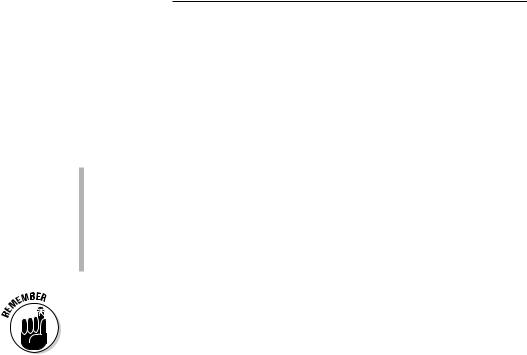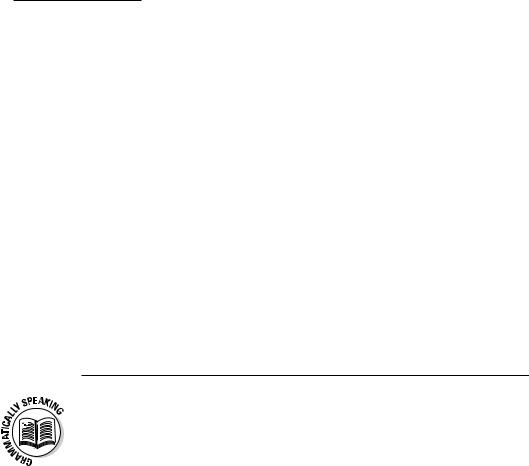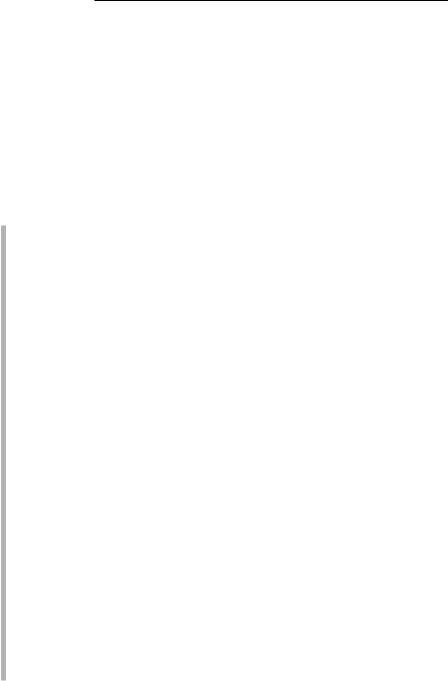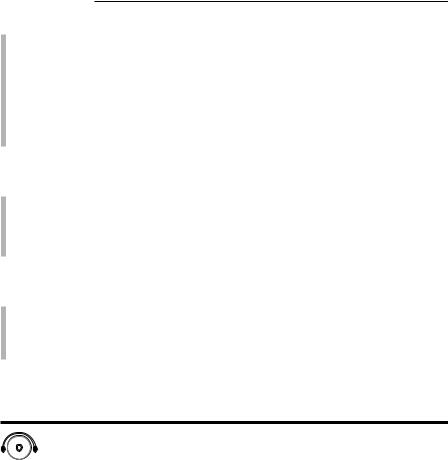
- •About the Authors
- •Dedication
- •Acknowledgments
- •Table of Contents
- •Introduction
- •About This Book
- •Conventions Used in This Book
- •Foolish Assumptions
- •How This Book Is Organized
- •Icons Used in This Book
- •Where to Go from Here
- •The French You’re Familiar With
- •Idioms and Popular Expressions
- •Key Parts of Speech
- •Cavorting with Verbs
- •Forming Sentences and Questions
- •The French Alphabet
- •Uttering Vowel and Consonant Sounds
- •Greetings: Formal and Friendly
- •Asking Questions to Get to Know People
- •Counting Your Lucky Stars: Numbers
- •Using the Calendar and Dates
- •Telling Time in French
- •Discussing Where You Live with the Verb “Habiter”
- •Discussing Daily Routine with Reflexive Verbs
- •Using Possessive Adjectives to Introduce Your Family Members
- •Basic Questions and Polite Expressions
- •Stating Your Preferences
- •Talking about Your Livelihood
- •Chatting about the Weather
- •Deciding to Keep in Touch
- •Getting Direction about Directions
- •Dining Out
- •Going to the Market
- •Going Shopping
- •Going Out with the Verb “Sortir”
- •Having Fun with the Verb “S’amuser”
- •Oh, the Places You’ll Go!
- •Making Plans with Friends
- •Making a Phone Call
- •Livin’ in the Past: Using the Past Tense
- •Playing Sports and Games
- •Going to the Beach
- •Setting Up Camp
- •Enjoying Quieter Pursuits
- •Where Do You Want to Go?
- •Getting Ready for Your Trip
- •Getting Current with Currency
- •Going to the Bank
- •Using Credit Cards and ATMs
- •Getting through the Airport
- •Navigating Buses, Trains, and Subways
- •Getting Around by Car
- •Finding Accommodations
- •Checking In to a Hotel
- •Checking Out of a Hotel
- •Getting Help Fast
- •Getting Medical Help
- •Handling Legal Matters
- •Label the Things in Your House
- •Write Your Shopping Lists in French
- •Listen to French Music
- •Watch French Movies
- •Tune in to TV5
- •Read French Publications
- •Take a Class
- •Join a French Association
- •Join an Online Chat or Pen Pal Forum
- •Using “Tu” When You Mean “Vous”
- •Using “Bonne nuit!” for Good-Bye
- •Using “Garçon” or “Porteur” to Address Service Staff
- •Saying “Je suis excité(e)” to Indicate Excitement
- •Saying “Je suis chaud(e)/froid(e)” to Say You’re Hot or Cold
- •Saying “Je suis plein/e” to Mean You’re Full
- •Using “de la glace” to Request Ice
- •Using “Je suis . . . ans” to Tell Your Age
- •Asking for Change with “J’ai besoin de change”
- •Using the Verb “Visiter” in Reference to People
- •“À mon avis”
- •“C’est pas vrai”
- •“Avec plaisir”
- •“C’est génial”
- •“À votre santé”
- •“À vos souhaits”
- •“Quelle horreur!”
- •“À bientôt”
- •“Passez-moi un coup de fil!”
- •“On y va!” or “Allons-y!”
- •“Je n’en sais rien”
- •“Je n’en reviens pas”
- •“Ça vaut la peine”
- •“C’est pas grave”
- •“N’importe”
- •“Tu cherches midi à 14h”
- •“Prenons un pot!”
- •Regular French Verbs
- •Auxiliary French Verbs
- •Track Listing
- •Customer Care
- •Index

244 Part III: French on the Go
Navigating Buses, Trains, and Subways
The public transportation system in most major cities of Europe and Canada is excellent. This section gives general information so you can research some fun and economical ways of getting to your favorite destinations. Check
out the following list for ideas on the range of choices available for getting around in various cities:
Montreal: Bus, subway, STCUM (urban train system), Amtrak, and VIA Rail (national train system)
Brussels: Subway, bus, tramway, and SNCB (national train system)
Geneva: Tramway, bus, trolleybus, and CFF (national train system)
Paris: Subway and RER (express trains between Paris and its suburbs), bus, SNCF (national train system), and tourist boats
When you get on the bus, or before you get on the train or subway, be sure to validate your ticket in a machine installed for that purpose. It gets awfully expensive when le contrôleur (luh kohN-troh-luhr) (the conductor, the ticket inspector) gets on and checks everybody. And they do!
Boarding the bus
If you have time, le bus (luh bews) (the bus) is probably the most wonderful way to get not only an impression of the different quartiers (kahr-tyey) (neighborhoods) of a city but also to experience that city’s people a bit. Busses are clean and pleasant and usually run on 15 to 30 minute intervals. The majority of bus stops in major cities are equipped with an electronic device, which shows when the next bus is expected. Also displayed in the bus stops are les lignes de bus (ley lee-nyuh duh bews) (bus routes) and neighborhood maps. Major cities have des excursions en bus (dey-zehk-skewr-zyohN ahN bews) (bus tours), which are a great and inexpensive way to see the city.
You can usually buy un billet (uhN bee-yeh) (a ticket) from le conducteur de bus (luh kohN-dew-ktuhr duh bews) (the bus driver), but remember that large bills are not welcome; it’s best to have the correct change (Chapter 14 covers money). Generally, buying tickets in a book of ten, un carnet (uhN kahr-neh), is cheaper. You can purchase these at metro stations or at any distributeur automatique (dees-tree-bew-tuhr oh-toh-mah-teek) (automated ticket vending machine). You may also purchase tickets at le guichet (luh gee-shey) (the ticket window). In many cities, the subway system is connected with the bus system, so you can use the same tickets.
www.ATIBOOK.ir

Chapter 15: Getting Around: Planes, Trains, Taxis, and More 245
Talkin’ The Talk
Mr. and Mrs. Meyer are at a bus stop. They are reading the bus schedule, but they’re not sure whether they’ve read it correctly. Bus number 82 is arriving. Mr. Meyer turns to la jeune femme (lah zhuhn fahm) (the young woman) next to him for help. (Track 17)
Mr. Meyer: Excusez-moi, mademoiselle. C’est bien le bus pour l’hôtel de ville?
ehk-skew-zey mwah, mahd-mwah-zehl. seh byaN luh bews poohr loh-tehl duh veel?
Excuse me, Miss. Is that the correct bus to City Hall?
La jeune femme: Non, il faut prendre le bus numéro 67.
nohN, eel foh prahN-druh luh bews new-mey- roh swah-sahN seht.
No, you have to take bus number 67.
Mr. Meyer: À quelle heure est-ce qu’il arrive? ah kehl uhr ehs-keel ah-reev?
What time does it come?
La jeune femme:: Il passe tous les quarts d’heure, mais il est souvent en retard.
eel pahs tooh ley kahr duhr, meh eel eh soohvahN ahN ruh-tahr.
It comes every 15 minutes, but it is often late.
Mr. Meyer: Et c’est à combien d’arrêts d’ici?
ey seh ah kohN-byaN dah-reh dee-see?
And how many stops is it from here?
La jeune femme: Ce n’est pas très loin, c’est le prochain arrêt.
Ah, le voilà! Il est à l’heure!
suh neh pah treh lwaN, seh luh proh-sheh-nah- reh. ah, luh vwah-lah! eel eh-tah luhr!
It’s not very far. It’s the next stop. Ah, there it is! It’s on time!
Mr. Meyer: Merci beaucoup. Au revoir. mehr-see boh-kooh. ohr-vwahr.
Thank you very much. Good-bye.
www.ATIBOOK.ir

246 Part III: French on the Go
Words to Know
l’hôtel de ville |
loh-tehl duh veel |
city hall |
il faut prendre |
eel foh prahN-druh |
you need to take |
il passe |
eel pahs |
it comes |
tous les quarts |
tooh ley kahr duhr |
every fifteen |
d’heure |
|
minutes |
souvent |
sooh-vahN |
often |
combien d’arrêts |
kohN-byaN dah-reh |
how many stops |
d’ici |
dee-see |
from here |
le prochain arrêt |
luh proh-sheh-nah-reh |
the next stop |
The adjective or pronoun tout (tooh) (all, every) has four forms (tout, toute, tous, toutes) because it agrees in gender and number with the noun it modifies or, as a pronoun, with the noun it replaces. Tous or toutes mean every when they are connected with a time definition in the plural, as in these examples:
tous les quarts d’heure (tooh ley kahr duhr) (every quarter of an hour) tous les jours (tooh ley zhoohr) (every day)
toutes les vingt minutes (tooht ley vaN mee-newt) (every 20 minutes)
When tout is connected with time definitions in the singular, however, it takes on a different meaning — all or something in its entirety, as these examples show:
toute la matinée (tooht lah mah-tee-ney) (all morning long, the whole morning, the entire morning)
toute la journée (tooht lah zhoohr-ney) (all day long, the whole day, the entire day)
toute la vie (tooht lah vee) (the entire life, the whole life)
www.ATIBOOK.ir

Chapter 15: Getting Around: Planes, Trains, Taxis, and More 247
Using the subway
The métro (mey-troh) (subway) is an economical and fast way to get around the city. Paris, Brussels, Lille, and Lyon, as well as Montreal, all have very efficient subway systems. Big maps in each station make the systems easy to use, and the hours of operation (usually from 5:30 a.m. to 1:00 a.m.) make it very convenient. In these cities, the fare is standard, no matter how far you travel. Here are some words that may come in handy when you’re at the métro:
la correspondance (lah koh-reh-spohN-dahNs) (transfer point, connection)
le guichet (luh gee-sheh) (ticket window)
la ligne (lah lee-nyuh) ([métro] line)
la place/le siège (lah plahs/luh syehzh) (seat)
le plan (luh plahN) (map)
le quai (luh key) (platform)
la sortie (lah sohr-tee) (the exit)
la station de métro (lah stah-syohN duh mey-troh) (métro station)
la voiture (lah vwah-tewr) (métro, car, train car)
Looking for ticket packages
A number of packages are available for tourists, which can include day or multiple-day passes, as well as weekly passes (you can read about these options in an upcoming list). If you are visiting Paris, for example, you should explore one of the several options available:
The Paris Visite (pah-ree vee-zeet) (a Paris visit pass), which you can use for unlimited trips on the métro, the bus, and the RER (Réseau Express Régional) (ehr uh ehr [rey-zoh ehk-sprehs rey-zhee-oh-nahl]), or the Montmartre Funiculaire (mohN-mahr-truh few-nee-kew-lehr), which saves you from climbing all those stairs when visiting Montmartre in the 18th district. This pass lets you choose the zones in which you’d like to travel, as well as the number of days. For more information, go
to www.parispass.com.
The Navigo Découverte (nah-vee-goh dey-kooh-vehrt) (Navigo discover pass), which is valid from Monday through Sunday, can be purchased to include unlimited use of the métro, RER, busses, transportation to the two airports, Charles de Gaulle (shahrl duh gohl) and Orly (ohrlee), as well as le Château de Versailles (luh shah-toh duh vehr-sahy) (the palace of Versailles) and Disney Park. For more information on the
www.ATIBOOK.ir

248 Part III: French on the Go
Navigo Découverte, check out www.transilien.com or http:// parisbytrain.com/paris-train-metro-week-pass-navigo- decouverte.
Un carnet (uhN kahr-neh) (a book of 10 tickets), which you can share with others traveling with you.
You can purchase any of these passes at ticket windows or ticket vending machines at métro, RER, or train stations. Some passes are also available at the Paris tourist office.
Buying your ticket
Most employees in the métro speak enough English to sell tickets and answer your questions. But just in case, here are some helpful phrases:
Un billet, s’il vous plaît. (uhN bee-yeh, seel vooh pleh.) (One ticket, please.)
Un carnet, s’il vous plaît. (uhN kahr-neh, seel vooh pleh.) (A book of
[ten]) tickets, please.)
Comment aller à. . . ? (koh-mahN-tah-ley ah. . . ?) (How do I get to. . . ?)
Quelle est la ligne pour. . . ? (kehl eh lah lee-nyuh poohr. . . ?) (Which line is it for. . .?)
Est-ce le bon sens pour aller à. . . ? (ehs luh bohN sahNs poohr ah-ley ah. . . ?) (Is this the right direction to go to. . . ?)
Est-ce qu’il faut prendre une correspondance? (ehs-keel foh prahNdrewn koh-reh-spohN-dahNs?) (Do I need to transfer?)
Où est la sortie, s’il vous plaît? (ooh eh lah sohr-tee, seel vooh pleh?) (Where is the exit, please?)
Talkin’ the Talk
Mr. Meyer and Mrs. Meyer split up for the morning to see different museums. Now it’s time to meet for lunch. Mr. Meyer wants to try out the subway, but he thinks he needs a map and stops at a kiosk.
Mr. Meyer: Bonjour. Est-ce que vous avez un plan de métro? bohN-zhoohr. ehs-kuh vooh-zah-vey uhN plahN duh mey-troh?
Hello. Do you have a metro map?
L’employée Le voici. . . . Est-ce que je peux vous aider?
luh vwah-see. . . . ehs-kuh zhuh puh vooh-zey-dey?
Here it is. . . . Can I help you?
www.ATIBOOK.ir

Chapter 15: Getting Around: Planes, Trains, Taxis, and More 249
Mr. Meyer: Oui, pour la Grande Place, c’est quelle ligne? wee, poohr lah grahNd plahs, seh kehl lee-nyuh?
Yes, to Grande Place, which line is it?
L’employée: C’est direct avec la ligne 3.
seh dee-rehkt ah-vehk lah lee-nyuh trwah.
You can go directly with line 3.
Mr. Meyer: Combien de temps est-ce qu’il faut? kohN-byaN duh tahN ehs-keel foh?
How long does it take?
L’employée: Disons . . . 20 minutes. dee-zohN. . .vaN mee-newt.
Let’s say . . . 20 minutes.
Mr. Meyer: Merci beaucoup, madame. mehr-see boh-kooh, mah-dahm.
Thank you very much, ma’am.
L‘employée: Je vous en prie.
zhuh vooh-zahN pree. You’re welcome.
Je vous en prie (zhuh vooh-zahN pree) is a more formal way of saying You are welcome. The more casual expression is Pas de quoi (paht kwah) a phrase you can make more formal by not abbreviating it: Il n’y a pas de quoi (eel nyah paht kwah). You can also say De rien (duh ryaN) (It’s nothing).
Getting around by train
If you’d like to travel through Europe, there is no better way than by rail. Trains in Europe are modern, clean, fast, and efficient. For long distance travel through Europe, trains are equipped with restaurants or café cars, as well as des couchettes (dey kooh-sheht) (berths) if you choose this option. A number of rail passes allow you to travel to the countries of your choice, but remember to purchase them ahead of time. Student and age discounts are also available, so don’t forget to ask for those. For more information on these rail passes, go to www.raileurope.com.
In addition, for long-distance traveling between France, Belgium, and the Netherlands, you may want to try the Train à Grande Vitesse (TGV) (traN ah grahNd vee-tehs [tey zhey vey]), an extra-high-speed train that you can use only with reservations. It is very fast and efficient, can take you across France
www.ATIBOOK.ir

250 Part III: French on the Go
in no time, and is truly worth the experience. The TGV Thalys (tey-zhey-vey tah-lee) runs Paris to Brussels to Amsterdam and back.
Also convenient, l’Eurostar/Le Shuttle (luh-roh stahr/luh shuh-tuhl) is a passenger Channel Tunnel link from London’s Waterloo train station to Paris and Brussels with no reservations necessary. The SNCF (Société Nationale des Chemins de Fer Français) (ehs ehn sey ehf [soh-see-ey-tey nah-syoh-nahl dey shuh-maN duh fehr frahN-seh]) is the French National Railroad System. There are six major gares (gahr) (train stations) in Paris alone.
Here are some useful words and phrases that can come in handy when you’re traveling by train:
le guichet (luh gee-sheh) (ticket window)
le quai (luh key) (platform)
les renseignements (ley rahN-seh-nyuh-mahN) (the information desk)
la consigne (lah kohN-see-nyuh) (baggage room)
la salle d’attente (lah sahl dah-tahNt) (waiting room)
le bureau des objets trouvés (leh bew-roh dey-zohb-zheh trooh-vey) (lost-and-found)
un [billet] aller-simple (uhN bee-yeh ah-ley-saN-pluh) (a one way [ticket])
un [billet] aller-retour (uhN bee-yeh ah-ley-ruh-toohr) (a round trip [ticket])
le compartiment (luh kohN-pahr-tee-mahN) (compartment)
composter (kohN-poh-stey) (to validate [a ticket])
la gare (lah gahr) (train station)
les heures de pointe (ley-zuhr duh pwaNt) (rush hour, peak)
la période creuse (lah pey-ree-ohd kruhz) (off peak)
l’horaire (loh-rehr) (the schedule)
l’indicateur (automatique) (laN-dee-kah-tuhr [oh-toh-mah-teek]) (automated train schedule)
un tarif réduit (uhN tah-reef rey-dwee) (reduced fare)
la voie (lah vwah) (track)
à bord (ah bohr) (on board)
à destination de (ah deh-stee-nah-syohN duh) (bound for)
direct(e) (dee-rehkt) (direct, non-stop)
www.ATIBOOK.ir

Chapter 15: Getting Around: Planes, Trains, Taxis, and More 251
Getting help at the train station
Train stations around the world are always busy, noisy, and confusing, but you can usually find helpful people around, such as the police and station employees, that you can turn to for direction.
You can use these questions to find what you’re looking for:
Pardon, où sont. . . ? (pahr-dohN, ooh sohN. . . ?) (Pardon, where are . . .?)
Excusez-moi, où est. . . ? (ehk-skew-zey-mwah, ooh eh. . . ?) (Excuse me, where is . . . ?)
Consider these examples:
Pardon, où sont les guichets? (pahr-dohN, ooh sohN ley gee-sheh?) (Pardon, where are the ticket windows?)
Excusez-moi, où est la salle d’attente? (ehk-skew-zey-mwah, ooh eh lah sahl dah-tahNt?) (Excuse me, where is the waiting room?)
When asking questions involving the words which or what, you use quel(s)/ quelle(s) (kehl), depending on whether the noun referred to is masculine or feminine and singular or plural. Quel and its other forms are adjectives and must be either followed by a noun with which they agree or separated from the noun by the verb être (eh-truh) (to be). Here are some examples:
Il arrive par quel train? (eel ah-reev pahr kehl traN?) (Which train is he arriving on?)
De quelle ville es-tu? (duh kehl veel eh-tew?) (Which city are you from?)
Quelles places avez-vous? (kehl plahs ah-vey-vooh?) (Which seats do you have?)
Quel est le nom de la gare? (kehl eh luh nohN duh lah gahr?) (What is the name of the train station?)
Quelles sont les heures de pointe? (kehl sohN ley-zuhr duh pwaNt?) (What are the peak hours?)
Buying tickets and checking the schedule
When you are traveling, you undoubtedly need to ask questions about plane and train schedules. Here are a few questions and answers that may come in handy.
Quand voulez-vous partir? (kahN vooh-ley-vooh pahr-teer?) (When do you want to leave?)
www.ATIBOOK.ir

252 Part III: French on the Go
Où voulez-vous aller? (ooh vooh-ley-vooh-zah-ley?) (Where do you want to go?)
Voulez-vous un aller-retour ou un aller-simple? (vooh-ley-vooh-zuhN ah-ley-ruh-toohr ooh uhN ah-ley-saN-pluh?) (Do you want a round trip or a one way?)
Pour combien de personnes? (poohr kohN-byaN duh pehr-sohhn?) (For how many people?)
Similarly, you may have some questions of your own:
A quelle heure y a-t-il un train pour. . . ? (ah kehl uhr ee ah-teel uhN traN poohr. . . ?) (What time is there a train for. . . ?)
Est-ce que le train est à l’heure? (ehs-kuh luh traN eh-tah luhr?) (Is the train on schedule/time?)
To this last question, you may get any of the following answers:
Le train est à l’heure. (luh traN eh-tah luhr.) (The train is on time.)
Le train est en avance. (luh traN eh-tahN-nah-vahNs.) (The train is early.)
Le train est en retard. (luh traN eh-tahN ruh-tahr.) (The train is late.)
Talkin’ the Talk
Susan wants to meet her old friend Julie in Versailles. So she takes a day off from her group and is trying her luck on her own. (Track 18)
L’employé: Bonjour, madame. Vous désirez? bohN-zhoohr, mah-dahm. vooh dey-zee-rey?
Good morning, ma’am. Can I help you?
Susan: Je voudrais un billet pour Versailles, s’il vous plaît. zhuh vooh-dreh uhN bee-yeh poohr vehr-sahy, seel vooh pleh.
I would like a ticket to Versailles, please.
L’employé: Aller-simple ou aller-retour? ah-ley-saN-pluh ooh ah-ley-ruh-toohr?
One way or round trip?
Susan: Aller-retour, s’il vous plaît. Deuxième classe. ah-ley-ruh-toohr, seel vooh pleh. duh-zee-ehm klahs.
Round trip, please. Second class.
www.ATIBOOK.ir
